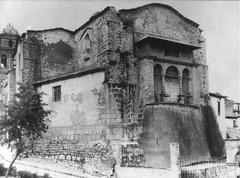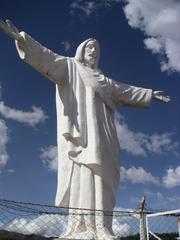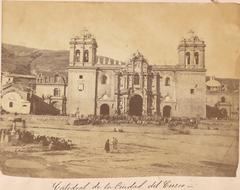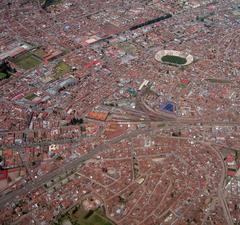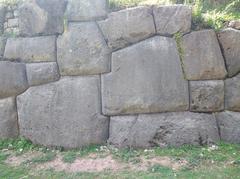Muyuq Marka Visiting Hours, Tickets, and Guide to Cusco Historical Sites
Date: 14/06/2025
Introduction
Nestled within the majestic Sacsayhuamán archaeological complex just north of Cusco, Peru, Muyuq Marka stands as a unique emblem of Inca architectural innovation and spiritual cosmology. Distinguished by its rare circular design—with triple concentric stone walls and a central courtyard—Muyuq Marka reflects the Incas’ advanced engineering and profound reverence for celestial phenomena (dbpedia.org; thebrainchamber.com). Constructed in the 15th century under Emperor Pachacutec, the site served both ceremonial and astronomical functions, notably as a Temple of Inti, the Sun God, and as a marker for solar alignments (machupicchuperutours.com; trek.zone).
Today, Muyuq Marka invites visitors to explore its enduring foundations, gain insight into its symbolic role as the “head” in Cusco’s puma-shaped city plan, and appreciate its sophisticated water engineering. Integrated within the larger Sacsayhuamán complex, Muyuq Marka offers a multifaceted experience of Inca urbanism, astronomy, and cultural festivities, such as the renowned Inti Raymi festival (ticketmachupicchu.com; annees-de-pelerinage.com). This guide provides comprehensive historical context, practical information on visiting hours, tickets, accessibility, and sustainable tourism practices to ensure a rewarding and responsible visit (myadventuresacrosstheworld.com; goodlifeexpeditions.com).
Table of Contents
- Introduction
- Origins and Construction of Muyuq Marka
- Architecture and Astronomical Significance
- Symbolism and Spiritual Importance
- Role in Inca Society and Urban Planning
- The Spanish Conquest and Archaeological Legacy
- Visiting Muyuq Marka: Essential Information
- Sustainable Tourism and Preservation
- Frequently Asked Questions (FAQ)
- Conclusion
- References
Origins and Construction of Muyuq Marka
Muyuq Marka, also known as Muyuqmarca or Muyucmarca, was built in the 15th century during the reign of Inca emperor Pachacutec (dbpedia.org). Its construction mobilized over 20,000 workers under the Inca mita system. The circular tower was fashioned from massive andesite stones—some exceeding 120 tons—assembled with such precision that even a knife blade cannot fit between the stones (machupicchuperutours.com).
Architecture and Astronomical Significance
Muyuq Marka’s architecture is unique among Inca sites for its triple concentric circular walls, interconnected by radial walls that once formed a tower of approximately 20 meters in height and four floors (annees-de-pelerinage.com; thebrainchamber.com). The construction employed the Inca’s signature ashlar masonry—finely cut stones fitted without mortar for seismic stability.
The site’s alignment is not arbitrary. Archaeological studies suggest the walls were positioned to mark the zenith sunrise and antizenith sunset, underlining the Incas’ sophisticated understanding of astronomy (trek.zone). The central court’s fountain possibly served as a ritual or astronomical feature, reflecting the cyclical nature of time and the cosmos.
Symbolism and Spiritual Importance
Muyuq Marka formed the symbolic “head” in the puma-shaped city plan of ancient Cusco—a sacred animal representing power and protection (ticketmachupicchu.com). Recognized as a Temple of Inti, the Sun God, the tower hosted rituals believed to maintain cosmic harmony and agricultural prosperity. Water channels and the central fountain highlighted the Andean reverence for water as a source of life (ticketmachupicchu.com).
Role in Inca Society and Urban Planning
Integrated into the Sacsayhuamán complex, Muyuq Marka was central to ceremonial, administrative, and defensive functions. The triple-walled tower, along with lost adjacent towers, likely facilitated elite rituals and astronomical observations. Its water channels connected to Cusco’s broader hydraulic system, exemplifying the Inca approach to blending infrastructure, spirituality, and daily life (ticketmachupicchu.com).
The Spanish Conquest and Archaeological Legacy
The Spanish conquest in the 16th century led to the systematic dismantling of Muyuq Marka and its towers—stones were repurposed for colonial buildings (ticketmachupicchu.com). Despite this, the surviving foundations remain a powerful reminder of the site’s original grandeur and continue to inspire awe among modern visitors.
Today, Muyuq Marka is a focal point for archaeological research and remains a living cultural link for local Quechua communities, especially during annual festivals like Inti Raymi (leadingperutravel.com).
Visiting Muyuq Marka: Essential Information
Visiting Hours
- Open daily, typically from 7:00 AM to 5:00 or 6:00 PM, with last entry around 5:00 PM. Hours may vary during festivals or special events (myadventuresacrosstheworld.com). Always verify with official tourism sources before your visit.
Tickets and Admission
- Access to Muyuq Marka is included with the Sacsayhuamán complex ticket, which is part of the Cusco Tourist Ticket (Boleto Turístico).
- Ticket prices (as of 2025):
- Full Tourist Ticket: 130 Peruvian Soles (~$35 USD) for international visitors
- Partial Ticket (includes Sacsayhuamán): 70 Soles (~$19 USD)
- Peruvian nationals: 70 Soles for the full ticket
- Tickets are valid for up to 10 days and available at Avenida El Sol 185 or at the site entrance.
Guided Tours and Travel Tips
- Guided tours (in English and Spanish) are available at the entrance and highly recommended for historical context (myadventuresacrosstheworld.com).
- Free or self-guided walking tours can also be arranged online (freewalkingtoursperu.com).
- Wear sturdy footwear and sun protection; bring water and allow time for acclimatization due to high altitude (alongdustyroads.com).
Accessibility
- The terrain is uneven and features stone steps, making wheelchair access difficult. Visitors with mobility issues should consult tour providers for possible accommodations.
Nearby Attractions
- Additional sites within the Cusco Tourist Ticket include Q’enqo, Puka Pukara, and Tambomachay.
- The city of Cusco itself, Sallaqmarca and Paucamarca towers, the Suchuna (Rolling Stone), and vibrant plazas and museums are easily accessible from Muyuq Marka.
Sustainable Tourism and Preservation
As visitation grows—especially during festivals like Inti Raymi—responsible travel is vital to protect Muyuq Marka’s fragile remains (UNWTO Sustainable Development). Key sustainable practices include:
- Staying on marked paths and respecting restricted areas
- Carrying out all waste and minimizing single-use plastics
- Supporting local guides, artisans, and businesses
- Participating respectfully in festivals and seeking permission before photography
- Choosing operators certified by bodies like the Global Sustainable Tourism Council (GSTC)
Preservation initiatives involve restricted access to sensitive zones, guided tours to manage group sizes, signage to direct visitor flow, and community-led education projects (thetempletrail.com; 1xmarketing.com). Infrastructure improvements such as waste collection and water conservation are ongoing (ScienceDirect).
Frequently Asked Questions (FAQ)
Q: What are Muyuq Marka’s visiting hours?
A: Usually 7:00 AM–5:00/6:00 PM daily; check for special events.
Q: Is entry included in the Sacsayhuamán ticket?
A: Yes, Muyuq Marka is part of the Sacsayhuamán complex, accessible with the Cusco Tourist Ticket.
Q: Are guided tours available?
A: Yes, on-site and private guides are available.
Q: Is the site accessible for wheelchairs?
A: Terrain is challenging; contact tour operators for possible accommodations.
Q: When is the best time to visit?
A: Early mornings and weekdays outside of festival periods are least crowded.
Q: Can I use drones at Muyuq Marka?
A: Generally prohibited without special permission.
Conclusion
Muyuq Marka remains a profound testament to Inca ingenuity, spiritual depth, and astronomical sophistication. Its unique circular architecture, triple concentric walls, and sacred water features embody a legacy that endures through centuries of change and challenge. Set within the larger Sacsayhuamán complex and surrounded by other major Cusco historical sites, Muyuq Marka offers visitors an immersive journey through the heart of Andean civilization.
For the best experience, plan your visit with attention to ticketing, accessibility, and sustainability. Embrace local customs, support preservation efforts, and consider participating in cultural festivities like Inti Raymi. Enhance your journey with digital tools such as the Audiala app, which provides guided tours and real-time updates.
By traveling thoughtfully and respectfully, you contribute to the preservation of Muyuq Marka and ensure its continued inspiration for generations to come.
References
- Muyuq Marka: Exploring the Historical and Cultural Heart of Cusco’s Iconic Inca Site – Visiting Hours, Tickets, and Visitor Guide, 2025 (dbpedia.org)
- Exploring Muyuq Marka: Visiting Hours, Tickets, and History of Cusco’s Circular Inca Monument, 2025 (thebrainchamber.com)
- Visitor Information and Practical Guidance, 2025 (myadventuresacrosstheworld.com)
- Muyuq Marka Visiting Hours, Tickets & Sustainable Tourism Guide in Cusco, Peru, 2025 (goodlifeexpeditions.com)
- UNWTO Sustainable Development, 2025 (UNWTO Sustainable Development)
- Machu Picchu Peru Tours: History of Sacsayhuaman, 2025 (machupicchuperutours.com)
- Trek.zone: Muyuq Marka Cuzco, 2025 (trek.zone)
- Ticket Machu Picchu: Sacsayhuaman Tower Muyucmarca, 2025 (ticketmachupicchu.com)
- Annees-de-Pelerinage.com: Sacsayhuaman Inca Ruins Cusco Peru, 2025 (annees-de-pelerinage.com)
- Evendo.com: Muyuq Marka, Cusco, Peru, 2025 (evendo.com)
